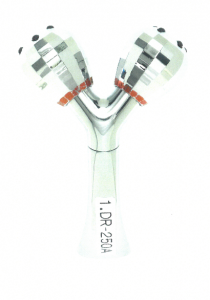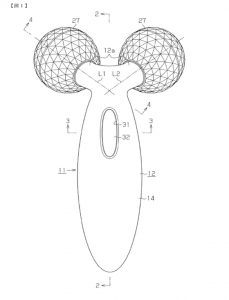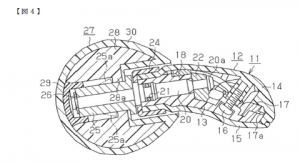Signs of Increasing Lost Profits Damages Awards In Japan May Signal Increased Value of Patent Ownership and Enforcement
A recent Japanese appellate court decision resulted in a four-fold increase over the lost profits damages awarded by the trial court. Whether the result of a 2019 revision to Japan’s patent law or not, there are signs that obtaining and enforcing patents in Japan may be becoming more valuable than believed in the past.
MTG Co., Ltd. owns patents relating to beauty care devices (facial massage rollers). MTG sued FIVE STARS Co. Ltd. for infringement in the Osaka District Court, seeking an injunction against sales of the accused infringing products, disposal of the inventory of infringing products, and compensatory damages for losses caused by the infringement. In the initial judgment by the trial court, FIVE STARS was found to have infringed the patents.
Both the plaintiff and the defendant filed requests for an appeal to the Intellectual Property High Court (IPHC). The Grand Panel of IPHC rendered its decision in this case on February 28, 2020.[1]With regard to calculation of an amount of damages under Article 102 (1) of the Japanese Patent Law, lost profit of the patentee is presumed to be the total amount of marginal profit that the patentee should have earned by selling its patented product in place of each infringing sale, even if features of the patented invention constitute only parts of the patented product. However, in the present case, it was determined that 40% of the marginal profit should be the measure, rather than the full amount, taking into consideration parts of the patented product other than the features of the patented invention, and further including consideration of which parts of the patented product actually caused consumers to buy it. In addition, in the present case, it was determined that some consumers who purchased infringing products would not have purchased patented products due to the significantly higher price than that of the infringing products and, therefore, the patentee would have been unable to sell the quantity that the infringer sold, according to the nature of the product and the price difference.
The alleged infringing product is shown on the right side.

A part of the claimed patent (one of two patent rights asserted by the patentee; Japanese Patent No. 5847904) is shown below.
[Claim 1] A beauty care device comprising: a support shaft secured to a handle on a base end to prevent from slipping off; and a rotating body rotatably supported on a top end of the supporting shaft, the beauty care device providing beauty effects on a human body using the rotating body, wherein the rotating body has a hole only on the base end, and the rotating body is supported by the supporting shaft via a bearing member in a non-penetrating state in which the top end of the supporting shaft is positioned inside the rotating body, wherein the bearing member is prevented from slipping off the support shaft on the top end which is opposite to the hole of the rotary body, an elastically deformable locking pawl projects from the bearing member, and the bearing member has a flange portion on a base end of the locking claw, wherein the locking claw has an inclined surface whose distance to a rotation center of the rotating body in the bearing member becomes shorter toward the top end side, and the rotating body has a step portion which is engagable with the locking pawl on an inner periphery, wherein the step portion is locked to the base end of the locking claw and is positioned between the locking claw and the flange portion.


An amount of compensation for patent infringement damages in Japan is calcuated under Article 709 of the Civil Code, which states as below.
(Compensation for Loss or Damage in Torts)
Article 709 A person that has intentionally or negligently infringed the rights or legally protected interests of another person is liable to compensate for damage resulting in consequence.
That is, in Japan, an amount of compensation for damages is limited to a range of damages (lost profit) resulted from a decrease in sales volume of patented products as a result of the sales of infringing products. Unlike in the United States or Korea, punitive (such as treble) damages are not available in Japan even in the case of intentional (willful) infringement. The party who files a request for damage compensation, i.e., the patentee, bears the burden of proving the amount of damages. However, because it is not easy to prove such an amount, the calculation method of the amount of damages is stipulated under Article 102 of the Japanese Patent Law, which is shown as below with emphasis.
(Presumption of Amount of Damage, etc.)
Article 102 (1) Where a patentee or an exclusive licensee claims against an infringer compensation for damage sustained as a result of the intentional or negligent infringement of the patent right or exclusive license, and the infringer assigned articles that composed the act of infringement, the amount of damage sustained by the patentee or the exclusive licensee may be presumed to be the amount of profit per unit of articles which would have been sold by the patentee or the exclusive licensee if there had been no such act of infringement, multiplied by the quantity (hereinafter referred to in this paragraph as the “assigned quantity”) of articles assigned by the infringer, the maximum of which shall be the amount attainable by the patentee or the exclusive licensee in light of the capability of the patentee or the exclusive licensee to work such articles; provided, however, that if any circumstances exist under which the patentee or the exclusive licensee would have been unable to sell the assigned quantity in whole or in part, the amount calculated as the number of articles not able to be sold due to such circumstances shall be deducted.
Article 102 was revised in 2019, one purpose of the revision being to increase compensatory awards for infringement; however, the decision in this case was made under the article prior to the revision.
According to the pre-2019 version of Article 102, the amount of damages is presumed to be (quantity of products sold by the infringer) x (amount of profit per unit of the products of the patentee), where
- the maximum of the amount of damages shall be the amount attainable by the patentee in light of the capability of the patentee to work such products, and
- if a circumstance exists under which the patentee would have been unable to sell the quantity of the products that the infringer sold, the amount corresponding to the quantity shall be deducted.
In the present case, the Grand Panel of IPHC issued the decision while specifically pointing out every key point of the law, as follows:
- Assigned quantity of articles that composed the act of infringement:
The trial court’s finding of infringement, and the assigned quantity of infringing products was upheld.
- Amount of profit per unit of articles which would have been sold by the patentee if there had been no such act of infringement:
- Articles that would have been sold if there had been no such act of infringement:
Generally, a product of a patentee and the like whose sales volume will be affected by an act of infringement, that is, a product of a patentee and the like which is in a competitive relation with an infringing product in the market is considered as the article that would have been sold if there had been no such act of infringement.
In the present case, patentee’s products that use the patented invention (patented products) were specified.
- Amount of profit per unit of articles:
Generally, the amount of profit per unit is an amount of marginal profit calculated by deducting, from sales price of a product of a patentee and the like, expenses that are directly relevant to production and sales of the product and are additionally required for the production and sales. Namely, it is an amount calculated by deducting, from a sales amount per unit of the product of the patentee and the like, producing cost and cost which is directly relevant to the production and sales of the patented product. Marginal profit may be thought of as being similar to incremental profit in the United States.
In the present case, in addition to the cost of production, the following additional costs and expenses were calculated and deducted: (i) sales commission, (ii) sales promotion cost, (iii) provision for point card certificates, (iv) product sample cost, (v) advertising expenses, (vi) packing and carriage, (vii) complaint handling expenses, (viii) provision for product guarantee expenses, and (ix) market research expenses. Expenses such as labor costs and transportation/communications expenses of administration department are not directly relevant to the production and sales of the patented product, and were considered not to be deducted from the sales amount. Among the expenses actually calculated, (i), (iii), (iv), and (vi) to (ix) were calculated by multiplying each cost occurring for all products of the patentee with a rate of the sales amount of the patented product to that of all products. Items (ii) and (v) were the amounts calculated by multiplying each cost occurring for all products of the brand to which the patented product belongs with the rate of the sales amount of the patented product to that of all products of the brand.
Generally, even if features of a patented invention constitute only parts of a product produced by working the patented invention by a patentee, a total amount of marginal profit earned by selling the patented product of the patentee is presumed to be the lost profit suffered by the patentee. However, in the present case, the Grand Panel stated that the parts significantly attracting consumers of the patented product of the plaintiff were not the part of the feature (the shape around the bearing) of the present patent, and “because the part of the feature did not contribute to the full profit of the sales of the product of the plaintiff, the total amount of marginal profit obtained by the sales of the product of the plaintiff shall not be presumed to be the lost profit of the plaintiff.” Accordingly, a part of the presumption is dismissed and the marginal profit was reduced by 60%. Also, it was stated that “the dismissal of the stipulated presumption was made by taking into consideration the degree of the contribution of the feature part to the profit of the sales of the patented product of the plaintiff, and shall not be made only based on the rate of the producing cost of the part.”
- Amount in light of the capability to work artcles:
Generally, “the capability to work articles” can be a potential capability. It is not limited to a capability to produce articles at its own plants or the like, and the patentee or the like are considered to have a capability to work articles (products) even if a quantity of products corresponding to the sales volume of an infringing product can be supplied by outsourcing the production and the like.
In the present case, it was considered that the patentee had the capability to sell the whole sales volume of the infringing products sold by the infringer.
- Circumstance under which the patentee would have been unable to sell the products:
The infringer (defendant) bears the burden of proving the circumtance under which the patentee (plaintiff) would have been unable to sell the products, and the amount corresponding to the quantity under such circumtance.
Generally, “the circumtance under which the patentee would have been unable to sell the products” means a circumtance that impedes a causal relation between the act of infringement and the decrease of sales volume of the product of the patentee and the like.
By way of exmaple, the circumtance may be (i) a difference in business types or prices between the patentee and the infringer (distinctiveness of the markets), (ii) existence of a competing product in the market, (iii) sales efforts of the infringer (brand popularity, advertisement), and (iv) a difference in performance (features other than the patented invention, such as functions and designs) between the infringing product and the product of the patentee.
In the present case, especially with regard to (i), the Grand Panel stated that although “the difference in selling prices may be considered as a circumtance under which the patentee would have been unable to sell the products”, “taking into consideration the nature of the alleged product, i.e., a beauty care device, there should be some consumers who do not place importance on the selling price, and purchase a cheap product if a cheap one is available but purchase an expensive one if no cheap product is available.” The selling price of the infringing product was 3,000 JPY to 5,000 JPY while the selling price of the product of the patentee was about 24,000 JPY. Nevertheless, the Grand Panel found that the patentee could absorb the sales to a certain number of consumers of the infringing product. With regard to (ii) to (iv), the infringer’s arguments were dismissed.
As a result of its re-calculation of the compensation owed by the infringer to the patentee, the Grand Panel essentially quadrupled the damages award from about US $1,000,000 to about US $4,000,000, representing a substantial victory on appeal for the patentee.
Observations and Comments
The number of patent applications in Japan peaked at approximately 440,000 in 2001 and declined to slightly over 310,000 in 2018. Such significant decline and stagnation has not been seen in U.S. or Europe. One factor may be that the amount of compensation for patent infringement damages in Japan has historically been very low and, as a result, many companies may have concluded that the expense of obtaining and maintaining patents in Japan does not provide sufficient benefit to outweigh those expenses. This concern was discussed in the patent system subcommittee of the Industrial Structure Council, which is an advisory body of Japan’s Ministry of Economy, Trade and Industry, which discussions led to the law revision in 2019. During the subcommittee deliberations, however, representatives of the Intellectual Property High Court stated that the amount of compensation for damages can be appropriately calculated by comprehensive consideration of cases even under the pre-2019 version of the law. The Grand Panel’s decision in the MTG v. FIVE STARS case may be an indication of that approach under the pre-revision version of Article 102; cases decided under the revised version of the law will show whether the patentee’s chances of obtaining meaningful compensatory damages for patent infringement are even further improved.
[1] Grand Panel of Intellectual Property High Court, Case No. 2019(Ne)10003.




